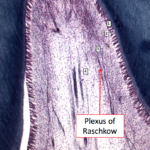
One of the most common diseases in the world, dental caries, continues to have an impact on people’s quality of life. Untreated deep carious lesions can cause pain, loss of function, and aesthetics, which can cause absences from work or school and low self-esteem. The dentine-pulp complex is affected by advanced carious lesions; caries has conventionally been treated by surgically removing the affected tissue, however the likelihood of pulp exposure or pulp vitality loss in carious teeth is increased because of this, particularly in deep carious lesions. To manage early enamel caries, non-invasive or minimally invasive treatment has typically been advised. Silver diamine flouride (SDF) is a non-invasive means of managing dental caries particularly in deciduous teeth to help arrest caries. However, its effect on the pulp has never been comprehensively studied.
In this review the dental pulp’s reaction to SDF treatment, including the inflammatory response, pulp cell activity, dentinogenesis, silver penetration, and the presence of bacteria in dental pulp has all been analysed.
Methods
ProQuest, SCOPUS, Web of Science, and PubMed were searched. The studies included clinical research demonstrating the impact of SDF on dental pulp, in-vivo studies using human or animal participants, or studies addressing the usage of SDF on vital dental pulp.
At least one of the following outcomes was required to gauge how SDF affects the dental pulp when used as a direct or indirect capping material:
- Inflammatory response, or all immunological reactions that were in place
- Pulpal cell activity, or the impact of SDF on the morphology, differentiation, and necrosis of cells
- Dentinogenesis, or the development of hard tissue
- Silver infiltration (the presence of silver particles in the dental pulp and dentinal tubules)
- The presence of microorganisms within the dentine-pulp complex, which has a bactericidal effect
Results
In this review, five studies—one case report, one in vivo research in people, one in vivo study in animals, one in-vitro study, and one study that involved in vivo testing in both humans and animals—that met the inclusion criteria were examined.
The findings were as follows:
- Inflammatory response – most of the studies found little to no inflammation of the pulp where SDF was applied indirectly, whereas when there was direct application to pulp, more severe changes to the pulp were observed
- Pulpal cell activity – most of the studies showed an increase in cellular activity where SDF was indirectly applied and where there was direct application there was mostly an inhibitory effect on pulpal cells
- Tertiary dentine formation – tertiary dentine formation was seen in all the teeth where SDF was indirectly applied to pulp. Where SDF was directly applied though, only 1 tooth showed tertiary dentine formation
- Silver penetration – none of the indirect application studies showed silver penetration into pulp
- Bacteria in pulp – one study showed the presence of dead microorganisms within the dentine tubules
Conclusions
The authors concluded: –
According to the limited available literature, direct SDF application causes pulp necrosis. Indirect SDF application is generally biocompatible to dental pulp tissue with a mild inflammatory response, increased odontoblastic activity, and increased tertiary dentine formation. Future studies with precise quantitative and qualitative tests, larger sample size and longer follow-up time are imperative to understand the biological activity of dental pulp to SDF treatment.
Comments
There were very few studies included in this review because during the filtration process only 5 studies actually observed the biological effects of SDF on pulp. None of these were clinical trials which is not surprising as there are ethical considerations to carrying out animal or human studies that would be a barrier to these being commenced. Furthermore, most of the studies in this review did not look at the long-term effects of SDF. Overall, the review did follow a methodical approach, but the weaknesses open the door for future more comprehensive studies to be done to help determine more precise uses of SDF.
There is certainly some evidence that SDF would not be suitable for direct application to pulp as indicated by the studies showing resultant pulpal necrosis in these cases (it should be noted that other agents such as calcium hydroxide also cause pulpal inflammation). There’s likely a place for increased indirect application of SDF as a more conservative means to treat caries, especially in deciduous teeth where mechanical caries removal is more dependent on patient cooperationNew clinical studies to collect data on adverse effects would aid a more accurate application protocol and improved understanding of risks.
Links
Primary Paper
Zaeneldin A, Yu OY, Chu CH. Effect of silver diamine fluoride on vital dental pulp: A systematic review. J Dent. 2022 Apr;119:104066. doi: 10.1016/j.jdent.2022.104066. Epub 2022 Feb 6. PMID: 35139409.
Other References
Greenwall-Cohen J, Greenwall L, Barry S. Silver diamine fluoride – an overview of the literature and current clinical techniques. Br Dent J. 2020 Jun;228(11):831-838. doi: 10.1038/s41415-020-1641-4. PMID: 32541740.
Dental Elf – 17thJul 2019
Dental Elf – 23rd Aug 2017
Dental Elf – 22nd Aug 2016
Picture Credits
By Dododopamine – Own work, CC BY-SA 4.0
